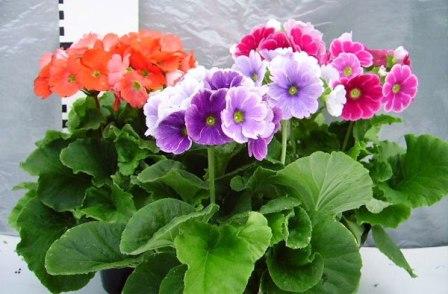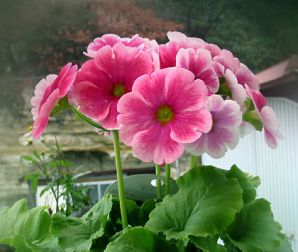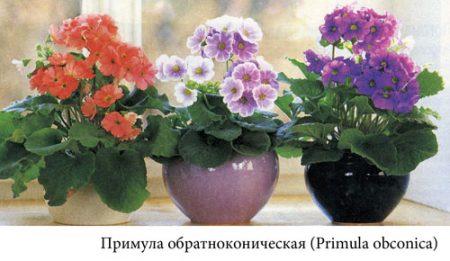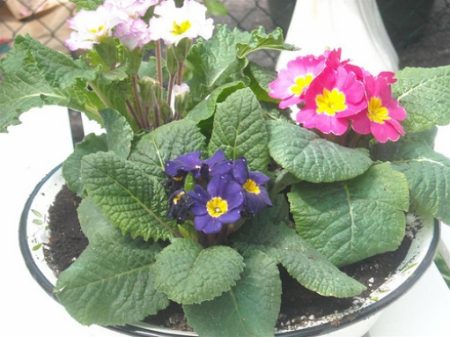 Indoor primrose: home care, photos and other recommendations regarding this beautiful plant, we will carefully consider in this material. When spring comes, a lot of primroses appear on the shelves, which can be planted not only in open ground, but also in your own home right on the windowsill.
Indoor primrose: home care, photos and other recommendations regarding this beautiful plant, we will carefully consider in this material. When spring comes, a lot of primroses appear on the shelves, which can be planted not only in open ground, but also in your own home right on the windowsill.
This plant is popularly called the "primrose", it is grassy and grows well in regions with a temperate climate. There are more than five hundred annual and perennial primroses in the world, many of them are suitable, including for home growing. The leaves of this plant have villi, differ in serrated edges and heart-shaped. What many flower growers like just primrose, so it is its diverse color. They can be yellow, and orange, blue, purple and white.
Interesting! Of all indoor plants, it’s primrose in spring begins to bloom before anyone else. Often this happens at the end of winter, if the plant should be provided with care. At the same time, magnificent flowering with a rich palette of colors lasts almost six months.
About home care
Where to put
Primrose room: home care, a photo after buying any plant will be beautiful. But in order for the flower to retain its appearance and begin to develop in your home, you need to find the best place for it. It is best for primrose western or north-western directions.

The action of direct sunlight primrose poorly tolerated. If there is no other option where to put the flower, then you must definitely shade the plant during the hours of the active sun.
About temperature
The optimal temperature for growing primrose at home is 12-15 degrees Celsius. If the air is warmer, then the flowers of primrose fall off quickly. When the flowering ends, then you can put the flower in a colder place or even plant it in the garden, and then, at the end of summer, return it to the house again.
About humidity and watering
As for air humidity, primrose will not have any special requirements. If the air is too dry, then the ends of the leaf may begin to dry. To prevent this from happening, regularly spray with water.
The soil in the pot should constantly be slightly moist, but at the same time, in no case should the plant be flooded, which can be detrimental to the root system. Use only soft water, that is, standing water and room temperature, for irrigation.
Advice! When the flowering is over, watering can be reduced to moderate, watering the primrose only after the final drying of the upper soil layer.
Top dressing
All indoor flowers need top dressing in the active period of growth and primrose is no exception. Indoor primrose: home care (see photo), regarding cultivation using fertilizers, is carried out when the first buds appear. This must be done during this period, so that the leaves do not take away all the nutrients from the small buds. For top dressing, you can safely take complex mineral fertilizer.

Advice! Until the end of flowering, from the moment the first buds appear, fertilizer should be carried out regularly every 15 days.
How to transplant
If the primrose is annual, then, of course, after flowering the plant can be thrown away. But, even some annual species of primrose can, if you continue to care for them, begin to grow again and bloom. Transplantation is carried out in early autumn.
When the primrose fades, it can be planted in open ground, divided into daughter sockets. You can also simply transplant the house into different pots. The land for transplantation is taken ordinary, but you should pay attention to the fact that in the mixture 20% was accounted for by sand.
Advice! A wide pot is selected for transplantation, but it should not be deep. Be sure in this situation, the presence of an additional drainage layer. Read more about how to save primrose before disembarkation.
Rules for care during illness:
- If the leaves become soft and lean down, this indicates too frequent watering.
- When spots appear on the ends of leaves, and not many buds are formed - this is an indicator of dry or hot air in the room.
- If the leaves become pale, this is a sign of chlorosis. It occurs due to a large amount of moisture, irrigation with hard water.
- Leaves that are pale at the edges that dry out are indications of a low temperature of content. The primrose in this situation just freezes.
- When the leaves are beautiful and large, but there are no flowers, this indicates a lack of light and a large amount of nitrogen in fertilizers.

Indoor primrose: home care, photos show how beautiful this potted plant can be. Be sure to decide to decorate your windowsill with this beautiful flower, and he will reciprocate the florist: elegant, long and lush flowering.


